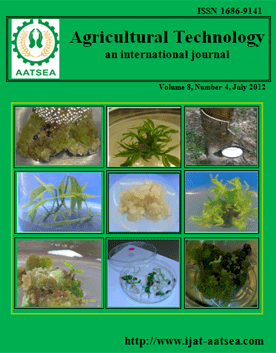ThaiScience
ThaiScience
INTERNATIONAL JOURNAL OF AGRICULTURAL TECHNOLOGY
Volume 15, No. 06, Month NOVEMBER, Year 2019, Pages 997 - 1010
Selection of ssr markers for drought resistant sugarcane in thailand
Prasitsom, C., Jubsab, N., Klomsa-ard, P., Sriroth, K. and Keawsompong, S.
Abstract Download PDF
Drought is the most significant environmental stress factor affecting agriculture worldwide and improving yield under drought conditions is a primary goal of plant breeding. In Thailand, sugarcane productivity decreased by approximately 12.5 tons/hectare from 2014 to 2016 as a result of drought. Drought tolerance comprises the combination of many characteristics. Indirect screening methods based on physiological and genomic traits are used to select drought-tolerant varieties with increased growth efficiency. Physiological traits observed in this study were stomatal conductance (gs), PSII maximum quantum yield (Fv/Fm), and leaf chlorophyll content (SPAD index). These were correlated with agronomic traits such as height, weight, and a number of stalks. Fourteen candidate SSR markers were selected as genomic data to determine the grouping relationship. Under drought conditions, our results indicated that maintaining higher photosynthetic efficiency (Fv/Fm) and chlorophyll content (SPAD index) showed the potential to achieve greater growth under water stress conditions. K93-219 had the highest values of physiological traits followed by KPS01-12, UT12, MPT10- 52, and MPT03-320, respectively. A phylogenetic tree of 4 SSR markers gave an interesting pattern suggesting that K93-219 and UT12 were close neighbor groups followed by MPT10-54 and KPS01-12, respectively. Results can be used to model selective varieties of sugarcane in Thailand. This research demonstrates an alternative method for screening sugarcane varieties that can adapt and grow under water stress conditions, and offers opportunities to develop breeding approaches for crop improvement in Thailand.
Keywords
SSR marker, sugarcane, physiology, droughtINTERNATIONAL JOURNAL OF AGRICULTURAL TECHNOLOGY
Published by : Association of Agricultural Technology in Southeast Asia (AATSEA)
Contributions welcome at : http://www.ijat-aatsea.com
